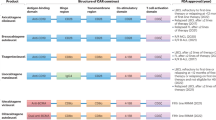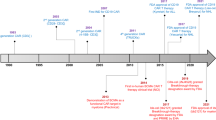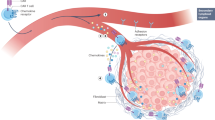Abstract
Although chimeric antigen receptor (CAR) T cell therapies have demonstrated promising clinical outcomes, durable remissions remain limited. To extend the efficacy of CAR T cells, we develop a CAR enhancer (CAR-E), comprising a CAR T cell antigen fused to an immunomodulatory molecule. Here we demonstrate this strategy using B cell maturation antigen (BCMA) CAR T cells for the treatment of multiple myeloma, with a CAR-E consisting of the BCMA fused to a low-affinity interleukin 2 (IL-2). This selectively induces IL-2 signaling in CAR T cells upon antigen–CAR binding, enhancing T cell activation and antitumor activity while reducing IL-2-associated toxicities. We show that the BCMA CAR-E selectively binds CAR T cells and increases CAR T cell proliferation, clearance of tumor cells and development of memory CAR T cells. The memory cells retain the ability to re-expand upon restimulation, effectively controlling tumor growth upon rechallenge. Mechanistic studies reveal the involvement of both CAR and IL-2 receptor endodomains in the CAR-E mechanism of action. The CAR-E approach avoids the need for specific engineering and enables CAR T cell therapy with lower cell doses.
This is a preview of subscription content, access via your institution
Access options
Access Nature and 54 other Nature Portfolio journals
Get Nature+, our best-value online-access subscription
$32.99 / 30 days
cancel any time
Subscribe to this journal
Receive 12 print issues and online access
$259.00 per year
only $21.58 per issue
Buy this article
- Purchase on SpringerLink
- Instant access to full article PDF
Prices may be subject to local taxes which are calculated during checkout






Similar content being viewed by others
Data availability
All relevant data are provided in this paper and Supplementary Information. RNAseq data generated in this study are available from the National Center for Biotechnology Information Sequence Read Archive (PRJNA1118916). The Ensembl H. sapiens database (https://useast.ensembl.org/Homo_sapiens/Info/Index) was used to identify RNA transcripts. Any remaining raw data are available from the corresponding author upon reasonable request.
Code availability
No custom code was developed for the analyses of the results.
References
Turtle, C. J. et al. CD19 CAR-T cells of defined CD4+:CD8+ composition in adult B cell ALL patients. J. Clin. Invest. 126, 2123–2138 (2016).
Roex, G. et al. Safety and clinical efficacy of BCMA CAR-T-cell therapy in multiple myeloma. J. Hematol. Oncol. 13, 164 (2020).
Raje, N. et al. Anti-BCMA CAR T-cell therapy bb2121 in relapsed or refractory multiple myeloma. N. Engl. J. Med. 380, 1726–1737 (2019).
Hartmann, J., Schüßler‐Lenz, M., Bondanza, A. & Buchholz, C. J. Clinical development of CAR T cells—challenges and opportunities in translating innovative treatment concepts. EMBO Mol. Med. 9, 1183–1197 (2017).
Lindner, S. E., Johnson, S. M., Brown, C. E. & Wang, L. D. Chimeric antigen receptor signaling: functional consequences and design implications. Sci. Adv. 6, eaaz3223 (2020).
Amini, L. et al. Preparing for CAR T cell therapy: patient selection, bridging therapies and lymphodepletion. Nat. Rev. Clin. Oncol. 19, 342–355 (2022).
Deng, H. et al. Efficacy of humanized anti-BCMA CAR T cell therapy in relapsed/refractory multiple myeloma patients with and without extramedullary disease. Front. Immunol. 12, 720571 (2021).
Rodriguez-Otero, P. et al. Ide-cel or standard regimens in relapsed and refractory multiple myeloma. N. Engl. J. Med. 388, 1002–1014 (2023).
Zhou, X., Rasche, L., Kortüm, K. M., Mersi, J. & Einsele, H. BCMA loss in the epoch of novel immunotherapy for multiple myeloma: from biology to clinical practice. Haematologica 108, 958–968 (2022).
San-Miguel, J. et al. Cilta-cel or standard care in lenalidomide-refractory multiple myeloma. N. Engl. J. Med. 389, 335–347 (2023).
Weinkove, R., George, P., Dasyam, N. & McLellan, A. D. Selecting costimulatory domains for chimeric antigen receptors: functional and clinical considerations. Clin. Transl. Immunol. 8, e1049 (2019).
Dai, Q. et al. 4-1BB signaling boosts the anti-tumor activity of CD28-incorporated 2nd generation chimeric antigen receptor-modified T cells. Front. Immunol. 11, 539654 (2020).
Majzner, R. G. et al. Tuning the antigen density requirement for CAR T-cell activity. Cancer Discov. 10, 702–723 (2020).
Cheng, Z. et al. In vivo expansion and antitumor activity of coinfused CD28- and 4-1BB-engineered CAR-T cells in patients with B cell leukemia. Mol. Ther. 26, 976–985 (2018).
Drent, E. et al. Combined CD28 and 4-1BB costimulation potentiates affinity-tuned chimeric antigen receptor-engineered T cells. Clin. Cancer Res. 25, 4014–4025 (2019).
Cherkassky, L. et al. Human CAR T cells with cell-intrinsic PD-1 checkpoint blockade resist tumor-mediated inhibition. J. Clin. Invest. 126, 3130–3144 (2016).
Rupp, L. J. et al. CRISPR/Cas9-mediated PD-1 disruption enhances anti-tumor efficacy of human chimeric antigen receptor T cells. Sci. Rep. 7, 737 (2017).
Fraietta, J. A. et al. Disruption of TET2 promotes the therapeutic efficacy of CD19-targeted T cells. Nature 558, 307–312 (2018).
Feucht, J. et al. Calibration of CAR activation potential directs alternative T cell fates and therapeutic potency. Nat. Med. 25, 82–88 (2019).
Agarwal, S. et al. Deletion of the inhibitory co-receptor CTLA4 enhances and invigorates chimeric antigen receptor T cells. Immunity 56, 2388–2407 (2023).
Hu, B. et al. Augmentation of antitumor immunity by human and mouse CAR T cells secreting IL-18. Cell Rep. 20, 3025–3033 (2017).
Chmielewski, M. & Abken, H. C. A. R. T. Cells releasing IL-18 convert to T-Bethigh FoxO1low effectors that exhibit augmented activity against advanced solid tumors. Cell Rep. 21, 3205–3219 (2017).
Hurton, L. V. et al. Tethered IL-15 augments antitumor activity and promotes a stem-cell memory subset in tumor-specific T cells. Proc. Natl Acad. Sci. USA 113, E7788–E7797 (2016).
Kueberuwa, G., Kalaitsidou, M., Cheadle, E., Hawkins, R. E. & Gilham, D. E. CD19 CAR T cells expressing IL-12 eradicate lymphoma in fully lymphoreplete mice through induction of host immunity. Mol. Ther. Oncolytics 8, 41–51 (2018).
Hawkins, E. R., D’Souza, R. R. & Klampatsa, A. Armored CAR T-cells: the next chapter in T-cell cancer immunotherapy. Biologics 15, 95–105 (2021).
Mohammed, S. et al. Improving chimeric antigen receptor-modified T cell function by reversing the immunosuppressive tumor microenvironment of pancreatic cancer. Mol. Ther. 25, 249–258 (2017).
Wang, Y. et al. An IL-4/21 inverted cytokine receptor improving CAR-T cell potency in immunosuppressive solid-tumor microenvironment. Front. Immunol. 10, 1691 (2019).
Sockolosky, J. T. et al. Selective targeting of engineered T cells using orthogonal IL-2 cytokine–receptor complexes. Science 359, 1037–1042 (2018).
Ma, L. et al. Enhanced CAR-T cell activity against solid tumors by vaccine boosting through the chimeric receptor. Science 365, 162–168 (2019).
Reinhard, K. et al. An RNA vaccine drives expansion and efficacy of claudin-CAR-T cells against solid tumors. Science 367, 446–453 (2020).
Quayle, S. N. et al. CUE-101, a novel E7–pHLA–IL2–Fc fusion protein, enhances tumor antigen-specific T-cell activation for the treatment of HPV16-driven malignancies. Clin. Cancer Res. 26, 1953–1964 (2020).
Cibrián, D. & Sánchez-Madrid, F. CD69: from activation marker to metabolic gatekeeper. Eur. J. Immunol. 47, 946–953 (2017).
Yu, A., Olosz, F., Choi, C. Y. & Malek, T. R. Efficient internalization of IL-2 depends on the distal portion of the cytoplasmic tail of the IL-2R common γ-chain and a lymphoid cell environment. J. Immunol. 165, 2556–2562 (2000).
Ali, S. A. et al. T cells expressing an anti-B-cell maturation antigen chimeric antigen receptor cause remissions of multiple myeloma. Blood 128, 1688–1700 (2016).
Cohen, A. D. et al. B cell maturation antigen-specific CAR T cells are clinically active in multiple myeloma. J. Clin. Invest. 129, 2210–2221 (2019).
Mailankody, S. et al. Orvacabtagene autoleucel (orva-cel), a B-cell maturation antigen (BCMA)-directed CAR T cell therapy for patients (pts) with relapsed/refractory multiple myeloma (RRMM): update of the phase 1/2 EVOLVE study (NCT03430011). J. Clin. Oncol. 38, 8504 (2020).
Kochenderfer, J. N. et al. Lymphoma remissions caused by anti-CD19 chimeric antigen receptor T cells are associated with high serum interleukin-15 levels. J. Clin. Oncol. 35, 1803–1813 (2017).
Smith, E. L. et al. Development and evaluation of an optimal human single-chain variable fragment-derived BCMA-targeted CAR T cell vector. Mol. Ther. 26, 1447–1456 (2018).
Works, M. et al. Anti-B-cell maturation antigen chimeric antigen receptor T cell function against multiple myeloma is enhanced in the presence of lenalidomide. Mol. Cancer Ther. 18, 2246–2257 (2019).
Ward, M. et al. A stable murine-based RD114 retroviral packaging line efficiently transduces human hematopoietic cells. Mol. Ther. 8, 804–812 (2003).
Li, G., Park, K. & Davila, M. L. Gammaretroviral production and T cell transduction to genetically retarget primary T cells against cancer. Methods Mol. Biol. 1514, 111–118 (2017).
Guimaraes, C. P. et al. Site-specific C-terminal and internal loop labeling of proteins using sortase-mediated reactions. Nat. Protoc. 8, 1787–1799 (2013).
Acknowledgements
Funding was provided by the Dana-Farber Cancer Institute Innovation Research Fund Award (M.R.), the Parker Institute for Cancer Immunotherapy (M.R., Grant no. C-03160), a Blavatnik Therapeutics Challenge Award (M.R., Grant no. 223813.5124476.0008) and an American Cancer Society postdoctoral fellowship (T.R., Grant no. PF-20-015-01-CCE). We thank the Boston University Micro and Nano Imaging Core Facility and Photonics Center for providing optical imaging support through Natural Science Foundation Major Research Instrumentation Awards 2215990 and DP2HL168562 (H.T.N.). We are grateful to I. Rubin-Bejerano, M. Namchuk, E. Smith and M. Goudarzi for helpful discussions. We thank Louise Clark for her technical assistance. We thank the National Cancer Institute-sponsored Biological Resource Branch Preclinical Biologics Repository for providing the anti-CD3 antibody (OK3) and IL-2, IL-7 and IL-15. We extend our gratitude to the microscopy core and the flow cytometry core within the Department of Cancer Immunology, as well as the dedicated animal facility staff at the Dana-Farber Cancer Institute and the Boston Children’s Hospital, for their invaluable support throughout this project.
Author information
Authors and Affiliations
Contributions
T.R., S.R.M., H.M., B.B.V.L., A.S.F., L.M., K.R., R.K., A.W., Z.F., M.C., A.K., A.N., U.-J.L., H.H.A., L.B., E.S., S.C.U., J.B., S.T., J.E.R., E.C., H.S. and J.P. designed and performed experiments and analyzed the results. C.A.J., O.N., H.T.N. and K.W.W. provided specific experimental advice and technical support. M.R. planned the experiments, analyzed the data and wrote the paper with help from the other authors.
Corresponding author
Ethics declarations
Competing interests
T.R. and M.R. are inventors on a related patent application. M.R. is the scientific founder of Koi Biotherapeutics. C.A.J. serves as a consultant for Kite/Gilead, Novartis, BMS, Sana, Synthekine, Janssen, Miltenyi, Caribou, Galapagos, ADC Therapeutics, AstraZeneca and Abbvie, and receives research funding from Kite/Gilead. O.N. receives research support from Takeda and Janssen, participates on advisory boards for Bristol Myers Squibb, Janssen, Sanofi, Takeda and GPCR Therapeutics, and receives honoraria from Pfizer. The other authors declare no competing interests.
Peer review
Peer review information
Nature Biotechnology thanks Christina Amatya and the other, anonymous, reviewer(s) for their contribution to the peer review of this work.
Additional information
Publisher’s note Springer Nature remains neutral with regard to jurisdictional claims in published maps and institutional affiliations.
Supplementary information
Supplementary Information
Supplementary Figs. 1–20 and Table 1.
Rights and permissions
Springer Nature or its licensor (e.g. a society or other partner) holds exclusive rights to this article under a publishing agreement with the author(s) or other rightsholder(s); author self-archiving of the accepted manuscript version of this article is solely governed by the terms of such publishing agreement and applicable law.
About this article
Cite this article
Rakhshandehroo, T., Mantri, S.R., Moravej, H. et al. A CAR enhancer increases the activity and persistence of CAR T cells. Nat Biotechnol 43, 948–959 (2025). https://doi.org/10.1038/s41587-024-02339-4
Received:
Accepted:
Published:
Issue date:
DOI: https://doi.org/10.1038/s41587-024-02339-4
This article is cited by
-
Regulators of CD8+ T cell exhaustion
Nature Reviews Immunology (2025)
-
Generation of NOD SCID mice with near-complete deletions of Il2rg and Prkdc for human cancer and HSC engraftment
Transgenic Research (2025)
-
Recent Advances in CAR-T Cell Therapy: from Dual Targeting To Emerging Innovations
Current Tissue Microenvironment Reports (2025)
-
The role of autoantibodies in bridging obesity, aging, and immunosenescence
Immunity & Ageing (2024)
-
Targeting systemic IL-2 to BCMA CAR-T cells
Nature Immunology (2024)



